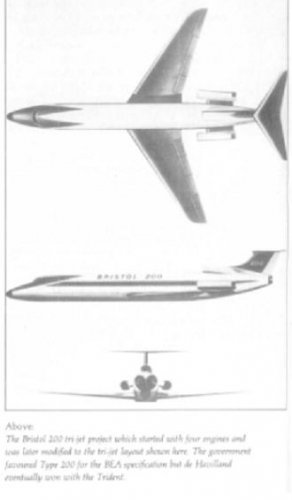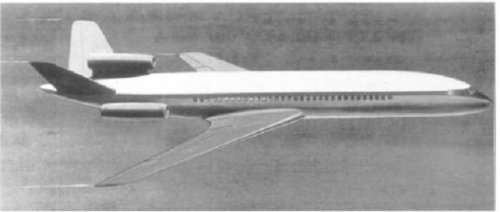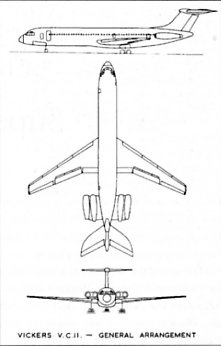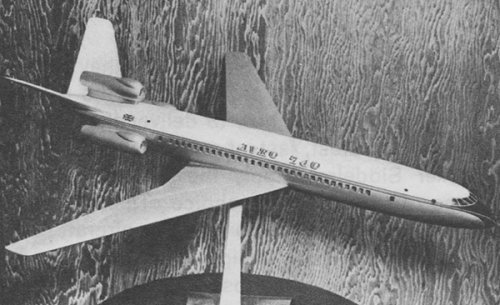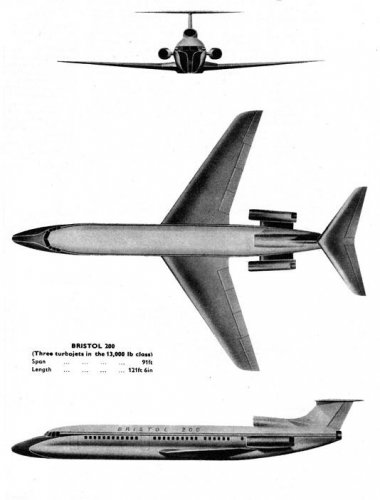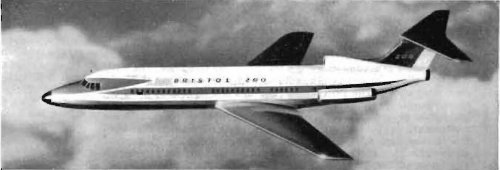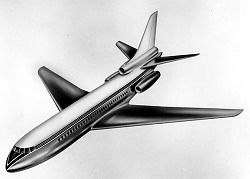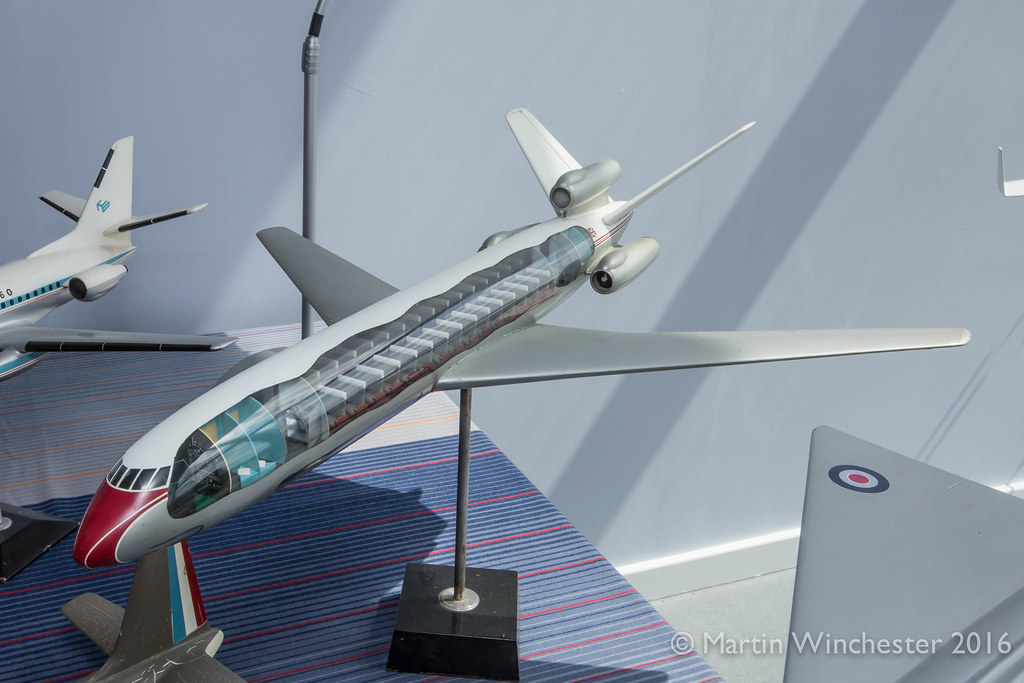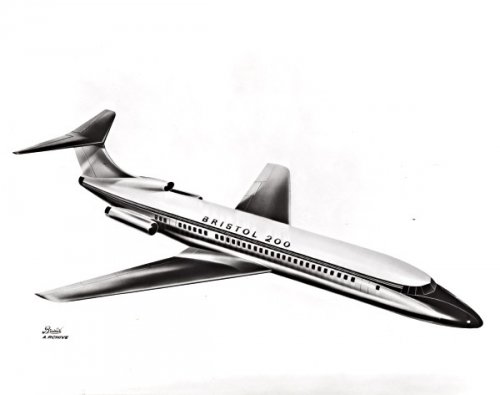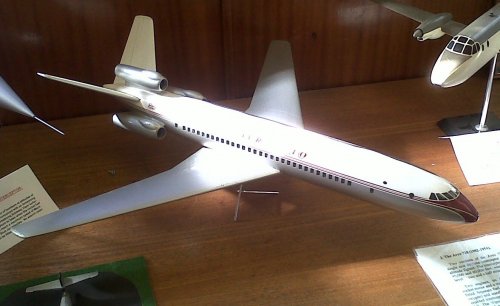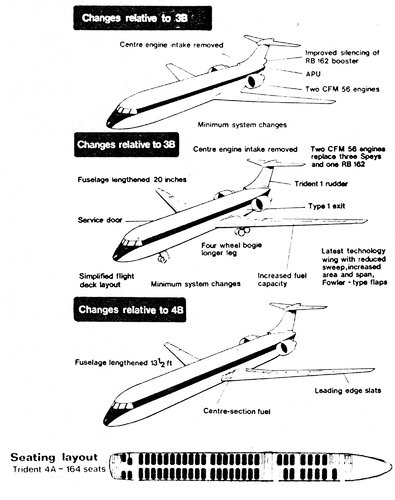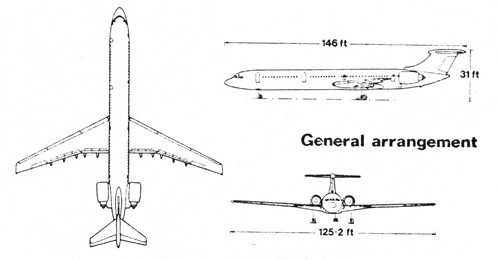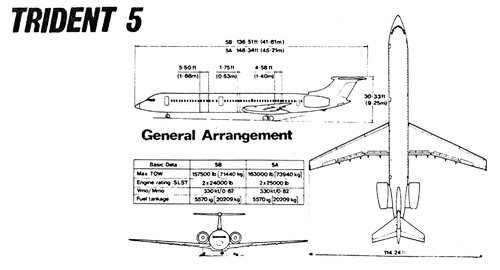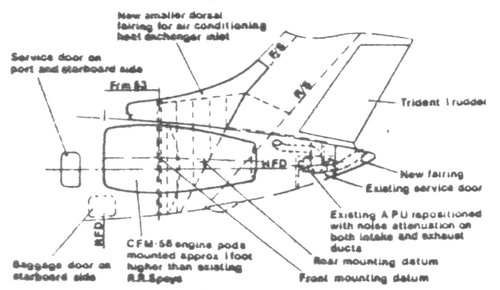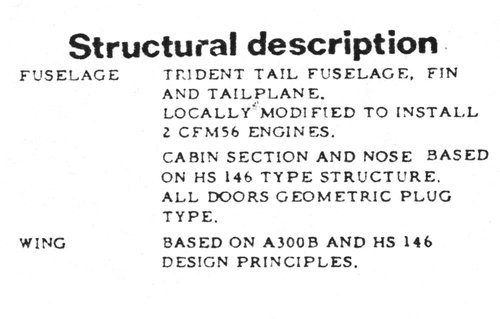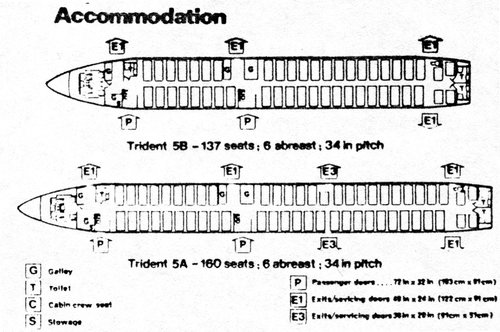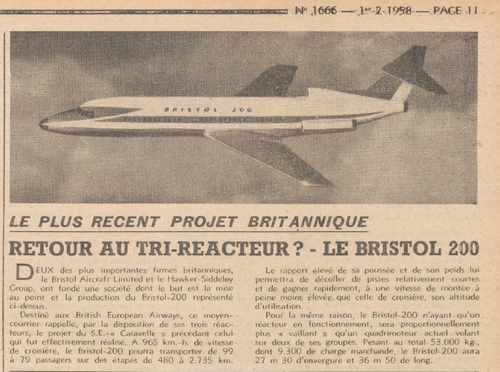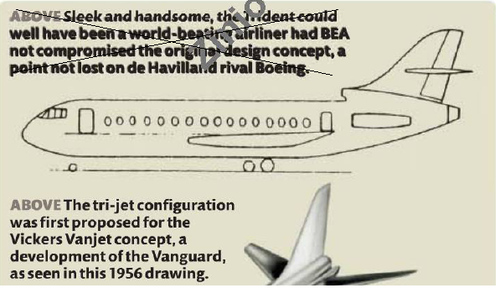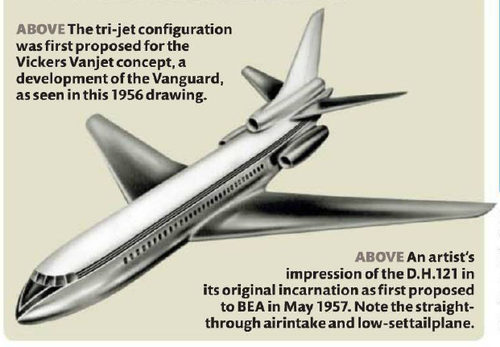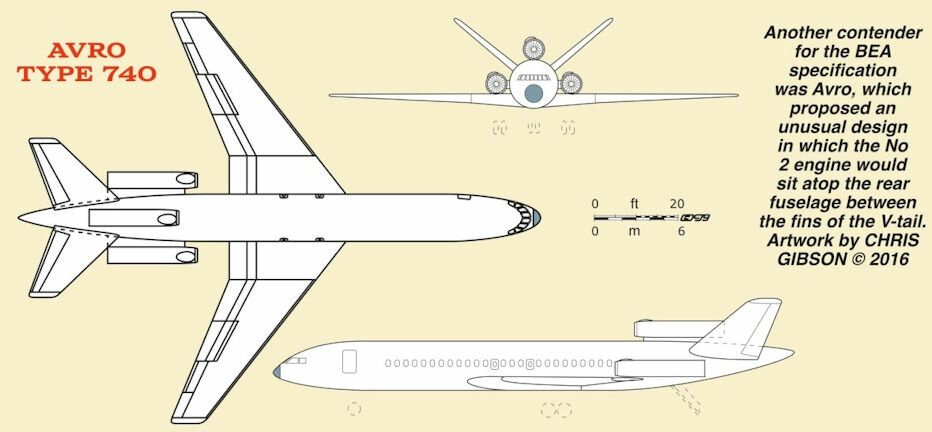You are using an out of date browser. It may not display this or other websites correctly.
You should upgrade or use an alternative browser.
You should upgrade or use an alternative browser.
Designs that led to the Hawker Siddeley Trident
- Thread starter PMN1
- Start date
-
- Tags
- cold war great britain
- Joined
- 22 January 2006
- Messages
- 4,216
- Reaction score
- 2,018
This is your book  :
:
Stuck on the Drawing Board: Unbuilt British Commercial Aircraft Since 1945: Payne, Richard: 9780752431727: Amazon.com: Books
Stuck on the Drawing Board: Unbuilt British Commercial Aircraft Since 1945 [Payne, Richard] on Amazon.com. *FREE* shipping on qualifying offers. Stuck on the Drawing Board: Unbuilt British Commercial Aircraft Since 1945
www.amazon.com
- Joined
- 26 May 2006
- Messages
- 34,911
- Reaction score
- 15,789
hesham said:Hi PMN1:
The Avro-740 was three engined airliner project,powered by 13540 1b Olympus 551s
and Bristol-200 was four engined design,powered by Orpheus later redesigned with
three engines.
Interesting tail on the Avro design.
pometablava said:Here's the VC11
Presumably that wasn't around when they offered the VC-10 for the Sheckelton replacement requirement to be told it was too big?
- Joined
- 22 January 2006
- Messages
- 4,216
- Reaction score
- 2,018
from "Stuck on the Drawing Board"
The VC11 began life as Type 1400, the design of which began in October 1959.Similar in design to a scaled down VC10 proposed for short to medium routes. All up weight: 170,000 lb and a range of 1500 nautical miles
BAC1-11
http://www.flightglobal.com/Articles/2006/12/19/Navigation/177/211153/Bad+choices%2c+poor+performers+.html
Section from the above article below
Probably the one UK airliner that could have been a world-beater was the BAC One-Eleven. First to market ahead of its US rivals, the 737 and DC-9, this Rolls-Royce Spey-powered 80- to 100-seater was the spiritual successor to the Viscount, achieving significant export success from the start, including major sales in the USA. But a lack of long-term development - hindered by the absence of a suitable engine for growth - meant the One-Eleven is remembered more for the noise it generated than a huge production run.
The BAC twinjet was also a victim of politics. When the newly created BAe opened for business in 1977 (following the merger of BAC with HSA), the government was looking for a flagship civil programme to herald the new era. Rather than warm up the One-Eleven, which was still in production at Hurn near Bournemouth, it was decided to resurrect an all-new regional airliner design that had been launched in the early 1970s, but had been cancelled due to lack of demand. The aircraft was the HS146 (redesignated the BAe 146), and thus was created that paradox of modern civil aviation - a regional jet with four engines.
Would the BAC1-11 be capable of being updated into a competitive aircraft if it had been redeveloped rather than developing the HS146?
If so, what aircraft would it be competing against?
http://www.flightglobal.com/Articles/2006/12/19/Navigation/177/211153/Bad+choices%2c+poor+performers+.html
Section from the above article below
Probably the one UK airliner that could have been a world-beater was the BAC One-Eleven. First to market ahead of its US rivals, the 737 and DC-9, this Rolls-Royce Spey-powered 80- to 100-seater was the spiritual successor to the Viscount, achieving significant export success from the start, including major sales in the USA. But a lack of long-term development - hindered by the absence of a suitable engine for growth - meant the One-Eleven is remembered more for the noise it generated than a huge production run.
The BAC twinjet was also a victim of politics. When the newly created BAe opened for business in 1977 (following the merger of BAC with HSA), the government was looking for a flagship civil programme to herald the new era. Rather than warm up the One-Eleven, which was still in production at Hurn near Bournemouth, it was decided to resurrect an all-new regional airliner design that had been launched in the early 1970s, but had been cancelled due to lack of demand. The aircraft was the HS146 (redesignated the BAe 146), and thus was created that paradox of modern civil aviation - a regional jet with four engines.
Would the BAC1-11 be capable of being updated into a competitive aircraft if it had been redeveloped rather than developing the HS146?
If so, what aircraft would it be competing against?
- Joined
- 27 December 2005
- Messages
- 17,752
- Reaction score
- 26,435
- Joined
- 20 January 2007
- Messages
- 953
- Reaction score
- 1,143
1-11/600 v.737/CFM56.It was a stroke of genius to overpower 737, derate and trade thrust for longevity. JT8D-17 was at 12,000hr TBO when GE/Boeing pitched 737-300/CFM-56/3, which was soon at 25,000hr. Fat Albert became Clockwork Albert. EFIS cockpit introduced soon thereafter, further reducing maintenance cost/man-hours p.flight hour. Boeing teamed with finance houses to offer innovative deals, such as the 737-200/ADV "walkaway" package that BA took in 1977 against new BAe's 146 offer...and flew these assets to 2002.
Private BAC and public RR, 1970-75 let MD80, 737-200/ADV leave them behind. The proud owner of BAe,1977, revived 1972 (ex-DH) 146 in hope of China business (it had been invented with 4 engines to follow-on Trident into CAAC's Lhasa routes, for which 2 engines were deemed inadequate). China span out their interest, a teaser in the context of HKG negotiations, and ended by buying 8 Short SD3/60. Beijing might have wanted to give UK the sop of some 146s, but the Users wanted shoals of 737s. Much later we got 10 146, later 8 more...by when 737-300 was surging in and out of Lhasa, throttled back.
Of course BAC could have done with 1-11 what MDC did to DC-9 and Boeing to 737-100: enhance, evolve, lighten, refine. All they needed to do was invest. UK Aero industry could not spell the word.
Private BAC and public RR, 1970-75 let MD80, 737-200/ADV leave them behind. The proud owner of BAe,1977, revived 1972 (ex-DH) 146 in hope of China business (it had been invented with 4 engines to follow-on Trident into CAAC's Lhasa routes, for which 2 engines were deemed inadequate). China span out their interest, a teaser in the context of HKG negotiations, and ended by buying 8 Short SD3/60. Beijing might have wanted to give UK the sop of some 146s, but the Users wanted shoals of 737s. Much later we got 10 146, later 8 more...by when 737-300 was surging in and out of Lhasa, throttled back.
Of course BAC could have done with 1-11 what MDC did to DC-9 and Boeing to 737-100: enhance, evolve, lighten, refine. All they needed to do was invest. UK Aero industry could not spell the word.
- Joined
- 30 November 2007
- Messages
- 1,126
- Reaction score
- 592
PMN1 said:Does anyone have information on the designs that led to the HS Trident - the Bristol 200, Avro 740, Vickers VC11 and De Havilland DH121 (any more??).
Dear PMN1, I'm not sure I can see how the Bristol 200, Avro 740 or Vickers VC11 could have "led" to the HS-121 Trident.
The Bristol 200 and Avro 740 were both unrelated competitors to the De Havilland DH-121 Trident for the same BEA specification for something to surpass the Sud Aviation Caravelle. The Avro 740 was dropped by Hawker-Siddeley (the parent company) when they decided to join up with Bristol in December 1957 to compete against De Havilland's "Airco" consortium (which also included Fairey Aviation and Hunting Aircraft; created to produce & market the DH-121 Trident).
The DH-121 Trident was a member of a range of post-Comet "projects" which shared the same six-abreast circular fuselage cross-section; including the DH-118, DH-119 & DH-120.
The De Havilland DH-121 Trident was selected by BEA in February 1958 with Government approval of this selection delayed to 1st August 1958; the Bristol 200 being the losing competitor. As we all know, De Havilland later redesigned the DH-121 Trident (into a smaller aircraft) for a 12th August 1959 order for 24 plus 12 options. De Havilland then merged with Hawker-Siddeley in April 1960 disbanding the "Airco" consortium, so the aircraft became the HS-121 Trident before it entered service......
The Vickers VC11 "project" didn't start until October 1959, several months after the DH-121 Trident had already been selected and a couple of months after the DH-121 Trident had been formally ordered......
Terry (Caravellarella)
- Joined
- 22 April 2012
- Messages
- 2,258
- Reaction score
- 2,309
The VC-11 seems to have drifted around for about 2 years through to 1961 with some considerable work done on the design. There was at least one commitment for aircraft (TCA) and based on reading flight global articles from the time it seems to have garnered significant interest, especially in Australia (ANA/TAA) and with Lufthansa. The nail in the coffin seems to have been the selection of the 727 by Lufthansa and the Australian airlines. VC11 was in roughly the same category as the original DH121 spec. This in turn seems to have resulted in the BAC107 being scaled up from an orhpeus (later BS.75) powered 48/56 passenger aircraft into the spey engined 1-11 when previously the intention had been for the BAC107 and VC11 to form the lower range of aircraft to the VC10/Super VC10 (also scaled down from the original 212 seat design) in the BAC lineup. It also seems like the BAC107 and the 1-11 biefly existed simultaneously though with little to no work being done on the former. At one stage there was a suggestion that both might get government launch aid. It is probably best if it does have its own thread.
BAC107: http://www.aviationarchive.org.uk/Gpages/html/G3912.html
Reading about this produced this beautiful little gem that lines up with my argument in another thread:
From: http://www.flightglobal.com/pdfarchive/view/1960/1960 - 2490.html
BAC107: http://www.aviationarchive.org.uk/Gpages/html/G3912.html
Reading about this produced this beautiful little gem that lines up with my argument in another thread:
The British industry has not been helped here over the years by its sales approach. One manufacturer recently made a prime mistake when one of its top executives made it plain to one operator here that any choice of a new aircraft was too important a decision to be made by anybody but the Government. I ask you
From: http://www.flightglobal.com/pdfarchive/view/1960/1960 - 2490.html
Last edited:
- Joined
- 30 November 2007
- Messages
- 1,126
- Reaction score
- 592
sealordlawrence said:The VC-11 seems to have drifted around for about 2 years through to 1961 with some considerable work done on the design. There was at least one commitment for aircraft (TCA) and based on reading flight global articles from the time it seems to have garnered significant interest, especially in Australia (ANA/TAA) and with Lufthansa. The nail in the coffin seems to have been the selection of the 727 by Lufthansa and the Australian airlines. VC11 was in roughly the same category as the original DH121 spec. u
Dear sealordlawrence, do you think the VC11 "project" deserves its own separate topic as it is quite obviously not a HS-121 Trident predecessor? By "commitment"; do you mean an actual contracted order or just an expression of intent to order?
Terry (Caravellarella)
Over fifty years ago I saw picture of another contender it looked like a narrow-body Lockheed TriStar it was suggested that this might have been Handley Page Scheme?
Has any one got a picture please?
Has any one got a picture please?
BillRo said:Here is a better 3 view of the Bristol 200
Story I heard once.
Chap from Hatfield giving a presentation on a method to optimise the design of a new aircraft.
"Any questions?"
"Have I got this right? If this method works, you could have fed in the Trident and got the 727?"
Chap from Hatfield giving a presentation on a method to optimise the design of a new aircraft.
"Any questions?"
"Have I got this right? If this method works, you could have fed in the Trident and got the 727?"
ysi_maniac
ACCESS: Confidential
- Joined
- 26 January 2007
- Messages
- 81
- Reaction score
- 33
- Joined
- 30 November 2007
- Messages
- 1,126
- Reaction score
- 592
http://www.secretprojects.co.uk/forum/index.php/topic,3082.msg282313.html#msg282313
zebedee
ACCESS: Secret
zebedee
ACCESS: Secret
Side on view... will be heading back for another photoshoot once they finish the Vulcan repainting...!
Zeb
 Avro 740 by Martin Winchester, on Flickr
Avro 740 by Martin Winchester, on Flickr
Zeb
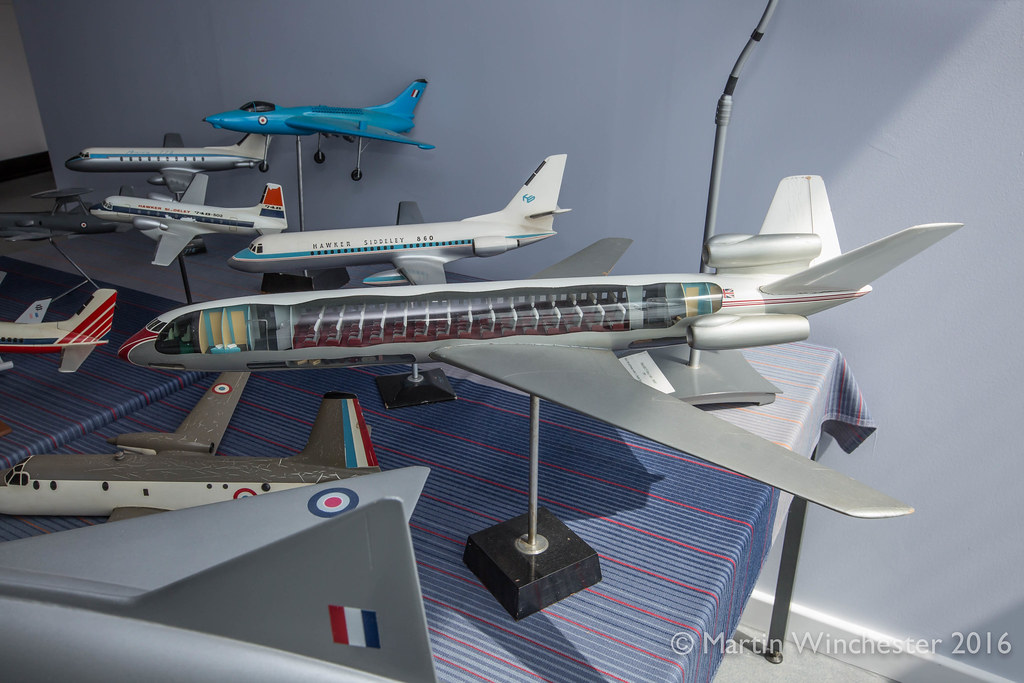 Avro 740 by Martin Winchester, on Flickr
Avro 740 by Martin Winchester, on Flickr- Joined
- 13 June 2007
- Messages
- 2,173
- Reaction score
- 3,095
Love all the display model photos you've posted - wonderful stuff!
Thanks! Mark
Thanks! Mark
- Joined
- 16 January 2015
- Messages
- 791
- Reaction score
- 3,607
JohnR said:Off topic, but what is the grey delta winged model in the foreground?
Regards.
Avro 720: https://www.flickr.com/photos/_infiniteplanes/27301057106/in/photostream/
The text to the model in reply # 18 is :
..An artist impression of the D.H 121 in its original incarnation as first proposed
to BEA in May 1957. Note the straight-trough airintake and the low-set tailplane...
Aeroplane Database :Hawker Siddeley Trident - November 2009
..An artist impression of the D.H 121 in its original incarnation as first proposed
to BEA in May 1957. Note the straight-trough airintake and the low-set tailplane...
Aeroplane Database :Hawker Siddeley Trident - November 2009
MaxLegroom
Why not?
- Joined
- 28 December 2013
- Messages
- 161
- Reaction score
- 49
Lovely pictures of the Avro 740! Also curious about the jet engined 748 in the background...
Source:
http://www.aviationarchive.org.uk/Gpages/html/G2198.html
http://www.aviationarchive.org.uk/Gpages/html/G2198.html
This is an artists impression of a proposed medium jet passenger aircraft from around 1956. It would have used the Bristol Orpheus gas turbine but stayed on the drawing board. This and other rear engined aircraft were schemed by the Bristol project office for sub sonic short to medium range routes. These were in parallel with the companies supersonic transport studies.
Attachments
- Joined
- 17 October 2006
- Messages
- 2,393
- Reaction score
- 1,197
One wonders how they expected to remove and install the #2 engine, particularly if it died away from a principal maintenance station.
zebedee
ACCESS: Secret
And now some evolutions of the Trident*... from the June 1987 Hatfield Future Projects Newsletter, design studies for the Trident 4 & 5 projects.
Trident 5 is the most modified with its cabin section and nose based on HS146 and wing based on A300B and HS146 design principles.
Zeb
"The following is a statement included in a departmental note of July 1975, which describes our participation in the development of this aircraft that led to both the Trident 4 and 5 projects.
Bearing in mind the size and design features of the Trident family, the twin engine developments are best suited to ratings of 24,000 lb and above. However, the possibilities with the CFM56 at its initial rating of 22,000 lb have merited serious consideration and means whereby a logical family development could be exploited, have been explored.
Derivatives have been examined with standard Trident wings, modified wings to give improved lift/drag characteristics, increased span and area and new wings based on developed A300 technology standards.
Capabilities with the standard wings are obviously limited. The Trident wing was designed for high speed capability, an attribute which pays off under certain operational conditions. The span (aspect ratio) however was matched for three low by-pass ratio engines and greater span is desirable for the twin configuration with high by-pass ratio propulsion. Consequently versions with the standard wing have been considered largely in the retrofit context and current proposals are based on the Trident 3B with or without the booster. If the booster is retained it will require hushing by some 6 - 7 PNdB.
Various modifications to the Trident wing have been considered. Some improvement in lift/drag characteristics is possible by adjustments to and cleaning up of the slat/flap configuration and this can be coupled with tip modifications or increased span.
For higher weight developments an increase in area is desirable and this can be achieved either by means of a centre section insert giving increased span and fuel capacity or by modification of the outer wing. Several schemes for the latter have been examines and involve a reduction of wing sweep from 35˚ to 27˚ on the outer panel, which in itself increases span.
Although such developments are feasible, study of the cost effectiveness in terms of the relationship between development costs, mission capability and economics, leads to the conclusion that a new wing, cashing in on all the advanced technology accumulated in the development of the A300 wing, is the best solution.
Such a new, reduced sweep, higher aspect ratio wing enables a progressive development of the derivative with development of engine thrust from 22,000 lb upwards. These developments with CFM56 and JT10D) engines are the basis of the present submissions for the Trident 4. "
*Apologies if this is the wrong thread but I can't find one for the Trident...!
Trident 5 is the most modified with its cabin section and nose based on HS146 and wing based on A300B and HS146 design principles.
Zeb
"The following is a statement included in a departmental note of July 1975, which describes our participation in the development of this aircraft that led to both the Trident 4 and 5 projects.
Bearing in mind the size and design features of the Trident family, the twin engine developments are best suited to ratings of 24,000 lb and above. However, the possibilities with the CFM56 at its initial rating of 22,000 lb have merited serious consideration and means whereby a logical family development could be exploited, have been explored.
Derivatives have been examined with standard Trident wings, modified wings to give improved lift/drag characteristics, increased span and area and new wings based on developed A300 technology standards.
Capabilities with the standard wings are obviously limited. The Trident wing was designed for high speed capability, an attribute which pays off under certain operational conditions. The span (aspect ratio) however was matched for three low by-pass ratio engines and greater span is desirable for the twin configuration with high by-pass ratio propulsion. Consequently versions with the standard wing have been considered largely in the retrofit context and current proposals are based on the Trident 3B with or without the booster. If the booster is retained it will require hushing by some 6 - 7 PNdB.
Various modifications to the Trident wing have been considered. Some improvement in lift/drag characteristics is possible by adjustments to and cleaning up of the slat/flap configuration and this can be coupled with tip modifications or increased span.
For higher weight developments an increase in area is desirable and this can be achieved either by means of a centre section insert giving increased span and fuel capacity or by modification of the outer wing. Several schemes for the latter have been examines and involve a reduction of wing sweep from 35˚ to 27˚ on the outer panel, which in itself increases span.
Although such developments are feasible, study of the cost effectiveness in terms of the relationship between development costs, mission capability and economics, leads to the conclusion that a new wing, cashing in on all the advanced technology accumulated in the development of the A300 wing, is the best solution.
Such a new, reduced sweep, higher aspect ratio wing enables a progressive development of the derivative with development of engine thrust from 22,000 lb upwards. These developments with CFM56 and JT10D) engines are the basis of the present submissions for the Trident 4. "
*Apologies if this is the wrong thread but I can't find one for the Trident...!
Attachments
- Joined
- 30 November 2007
- Messages
- 1,126
- Reaction score
- 592
And now some evolutions of the Trident*... from the June 1987 Hatfield Future Projects Newsletter, design studies for the Trident 4 & 5 projects.
Trident 5 is the most modified with its cabin section and nose based on HS146 and wing based on A300B and HS146 design principles.
Zeb
"The following is a statement included in a departmental note of July 1975, which describes our participation in the development of this aircraft that led to both the Trident 4 and 5 projects.
Bearing in mind the size and design features of the Trident family, the twin engine developments are best suited to ratings of 24,000 lb and above. However, the possibilities with the CFM56 at its initial rating of 22,000 lb have merited serious consideration and means whereby a logical family development could be exploited, have been explored.
Derivatives have been examined with standard Trident wings, modified wings to give improved lift/drag characteristics, increased span and area and new wings based on developed A300 technology standards.
Capabilities with the standard wings are obviously limited. The Trident wing was designed for high speed capability, an attribute which pays off under certain operational conditions. The span (aspect ratio) however was matched for three low by-pass ratio engines and greater span is desirable for the twin configuration with high by-pass ratio propulsion. Consequently versions with the standard wing have been considered largely in the retrofit context and current proposals are based on the Trident 3B with or without the booster. If the booster is retained it will require hushing by some 6 - 7 PNdB.
Various modifications to the Trident wing have been considered. Some improvement in lift/drag characteristics is possible by adjustments to and cleaning up of the slat/flap configuration and this can be coupled with tip modifications or increased span.
For higher weight developments an increase in area is desirable and this can be achieved either by means of a centre section insert giving increased span and fuel capacity or by modification of the outer wing. Several schemes for the latter have been examines and involve a reduction of wing sweep from 35˚ to 27˚ on the outer panel, which in itself increases span.
Although such developments are feasible, study of the cost effectiveness in terms of the relationship between development costs, mission capability and economics, leads to the conclusion that a new wing, cashing in on all the advanced technology accumulated in the development of the A300 wing, is the best solution.
Such a new, reduced sweep, higher aspect ratio wing enables a progressive development of the derivative with development of engine thrust from 22,000 lb upwards. These developments with CFM56 and JT10D) engines are the basis of the present submissions for the Trident 4. "
*Apologies if this is the wrong thread but I can't find one for the Trident...!
There probably was a separate thread for Trident derivatives but most likely it was merged into another as often happens here......
Terry (Caravellarella)
Trust12002
ACCESS: Restricted
- Joined
- 28 October 2020
- Messages
- 15
- Reaction score
- 27
It was the Trident and it wasn't by Handley Page but de Havilland (DH 121) By 1967 it wasn't a proposal but already being built for BEA. As originally proposed it was the same size as the similar Boeing 727, which was also being peddled in the late 60's. but DH were stuck with the British launch customer influence that earlier allowed BOAC to blight the Bristol Britannia. BEA insisted on 70-80 seats to the 727's 100. The 727 sold the Trident did not. BEA duly decided that they did want more seats and the final mark 3c Trident had 150. Naturally for the smaller aircraft smaller RR Spey engines had been chosen and the bigger RR Medway abandoned. For the 3c a fourth engine was fitted, an RB 162 lift engine used only for take off boost. Total Trident production was 117. Total 727 production was 1832. The Trident did have one distinction, it was fast. The cruise Mach number was 0.88, the highest for such an aircraft at that time. You can see a Trident at Duxford.
Darklord,
Do you remember a model of a proposed three jet UK airliner circa 1956/7 for BEA configured like a narrow body Tristar? I just can not remember who the design company was?
Yes I think it was the Trident, possibly by Handley Page.
Sentinel Chicken
American 71 Heavy, contact departure 126.47
I had read in another book that there was one Trident 5 design that had a Trident nose, T-tail, but RB.211 engines on wing nacelles and it looked a lot like the early 757 designs that had a 727 nose and T-tail. Was there such a design evolution of the Trident 5?And now some evolutions of the Trident*... from the June 1987 Hatfield Future Projects Newsletter, design studies for the Trident 4 & 5 projects.
Trident 5 is the most modified with its cabin section and nose based on HS146 and wing based on A300B and HS146 design principles.
Zeb
"The following is a statement included in a departmental note of July 1975, which describes our participation in the development of this aircraft that led to both the Trident 4 and 5 projects.
Bearing in mind the size and design features of the Trident family, the twin engine developments are best suited to ratings of 24,000 lb and above. However, the possibilities with the CFM56 at its initial rating of 22,000 lb have merited serious consideration and means whereby a logical family development could be exploited, have been explored.
Derivatives have been examined with standard Trident wings, modified wings to give improved lift/drag characteristics, increased span and area and new wings based on developed A300 technology standards.
Capabilities with the standard wings are obviously limited. The Trident wing was designed for high speed capability, an attribute which pays off under certain operational conditions. The span (aspect ratio) however was matched for three low by-pass ratio engines and greater span is desirable for the twin configuration with high by-pass ratio propulsion. Consequently versions with the standard wing have been considered largely in the retrofit context and current proposals are based on the Trident 3B with or without the booster. If the booster is retained it will require hushing by some 6 - 7 PNdB.
Various modifications to the Trident wing have been considered. Some improvement in lift/drag characteristics is possible by adjustments to and cleaning up of the slat/flap configuration and this can be coupled with tip modifications or increased span.
For higher weight developments an increase in area is desirable and this can be achieved either by means of a centre section insert giving increased span and fuel capacity or by modification of the outer wing. Several schemes for the latter have been examines and involve a reduction of wing sweep from 35˚ to 27˚ on the outer panel, which in itself increases span.
Although such developments are feasible, study of the cost effectiveness in terms of the relationship between development costs, mission capability and economics, leads to the conclusion that a new wing, cashing in on all the advanced technology accumulated in the development of the A300 wing, is the best solution.
Such a new, reduced sweep, higher aspect ratio wing enables a progressive development of the derivative with development of engine thrust from 22,000 lb upwards. These developments with CFM56 and JT10D) engines are the basis of the present submissions for the Trident 4. "
*Apologies if this is the wrong thread but I can't find one for the Trident...!
zebedee
ACCESS: Secret
Are you thinking of 1967's HS134 with the RB178? Will dive into the archive as I think there is a picture of it somewhere in my Hatfield documents. Derek Wood mentions it in Project Cancelled on p.227-229 and certainly looks very 757 like...I had read in another book that there was one Trident 5 design that had a Trident nose, T-tail, but RB.211 engines on wing nacelles and it looked a lot like the early 757 designs that had a 727 nose and T-tail. Was there such a design evolution of the Trident 5?And now some evolutions of the Trident*... from the June 1987 Hatfield Future Projects Newsletter, design studies for the Trident 4 & 5 projects.
Trident 5 is the most modified with its cabin section and nose based on HS146 and wing based on A300B and HS146 design principles.
Zeb
"The following is a statement included in a departmental note of July 1975, which describes our participation in the development of this aircraft that led to both the Trident 4 and 5 projects.
Bearing in mind the size and design features of the Trident family, the twin engine developments are best suited to ratings of 24,000 lb and above. However, the possibilities with the CFM56 at its initial rating of 22,000 lb have merited serious consideration and means whereby a logical family development could be exploited, have been explored.
Derivatives have been examined with standard Trident wings, modified wings to give improved lift/drag characteristics, increased span and area and new wings based on developed A300 technology standards.
Capabilities with the standard wings are obviously limited. The Trident wing was designed for high speed capability, an attribute which pays off under certain operational conditions. The span (aspect ratio) however was matched for three low by-pass ratio engines and greater span is desirable for the twin configuration with high by-pass ratio propulsion. Consequently versions with the standard wing have been considered largely in the retrofit context and current proposals are based on the Trident 3B with or without the booster. If the booster is retained it will require hushing by some 6 - 7 PNdB.
Various modifications to the Trident wing have been considered. Some improvement in lift/drag characteristics is possible by adjustments to and cleaning up of the slat/flap configuration and this can be coupled with tip modifications or increased span.
For higher weight developments an increase in area is desirable and this can be achieved either by means of a centre section insert giving increased span and fuel capacity or by modification of the outer wing. Several schemes for the latter have been examines and involve a reduction of wing sweep from 35˚ to 27˚ on the outer panel, which in itself increases span.
Although such developments are feasible, study of the cost effectiveness in terms of the relationship between development costs, mission capability and economics, leads to the conclusion that a new wing, cashing in on all the advanced technology accumulated in the development of the A300 wing, is the best solution.
Such a new, reduced sweep, higher aspect ratio wing enables a progressive development of the derivative with development of engine thrust from 22,000 lb upwards. These developments with CFM56 and JT10D) engines are the basis of the present submissions for the Trident 4. "
*Apologies if this is the wrong thread but I can't find one for the Trident...!
Edit: Found it, will post later after I've scanned it... along with what may be a 1977 refresh with a 146 style nose simply named JET 001...
Zeb
Last edited:
Similar threads
-
British DC-3/Rapide Replacement Competition of 1953-55
- Started by hesham
- Replies: 1
-
-
-
Hawker HS.141 VTOL airliner, HS.140 VTOL business jet
- Started by GTX
- Replies: 53
-
Hawker Hunter Precursor and Follow-on Projects
- Started by hesham
- Replies: 67

